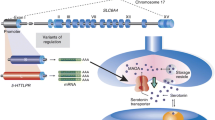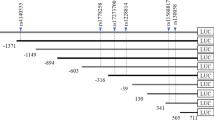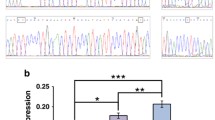Abstract
A wide range of physiological processes and neuronal functioning is modulated by the serotonergic system. Serotonin (5-HT) plays an important role during early brain development. Moreover, dysfunction of the 5-HT system is implicated in psychiatric disorders, especially in affective disorders. Little is known, however, about the transcriptional mechanisms leading to a functional 5-HT system in humans. The Fifth Ewing Variant (FEV), an E-twenty-six (ETS) transcription factor, is assumed to be involved in the transcription of gene(s) in the serotonergic pathway and to play a role in early brain development. To investigate its specificity, we performed an expression analysis of FEV in different human brain regions utilizing quantitative real-time polymerase chain reaction. Our results demonstrate that FEV is not exclusively expressed in serotonergic neurons, but, on the contrary, also in several non-serotonergic brain regions such as locus coeruleus, caudate nucleus and putamen. In the latter two regions, FEV expression levels actually were higher when compared with the pons and the medulla oblongata, which contain the raphe nuclei. Additionally, we examined whether genetic variance in the FEV gene contributes to the susceptibility towards affective disorders. Direct re-sequencing, however, did not provide evidence for FEV mutations in patients, and neither were non-coding single nucleotide polymorphisms associated with disease. FEV therefore might not account for the genetic risk towards depression or bipolar disorder. Furthermore, the specificity of FEV for the serotonergic system should be reconsidered.


Similar content being viewed by others
References
Aronov S, Aranda G, Behar L, Ginzburg I (2001) Axonal tau mRNA localization coincides with tau protein in living neuronal cells and depends on axonal targeting signal. J Neurosci 21:6577–6587
Cordes SP (2005) Molecular genetics of the early development of hindbrain serotonergic neurons. Clin Genet 68:487–494
Fyodorov D, Nelson T, Deneris E (1998) Pet-1, a novel ETS domain factor that can activate neuronal nAchR gene transcription. J Neurobiol 34:151–163
Hendricks T, Francis N, Fyodorov D, Deneris ES (1999) The ETS domain factor Pet-1 is an early and precise marker of central serotonin neurons and interacts with a conserved element in serotonergic genes. J Neurosci 19:10348–10356
Hendricks TJ, Fyodorov DV, Wegman LJ, Lelutiu NB, Pehek EA, Yamamoto B, Silver J, Weeber EJ, Sweatt JD, Deneris ES (2003) Pet-1 ETS gene plays a critical role in 5-HT neuron development and is required for normal anxiety-like and aggressive behavior. Neuron 37:233–247
Iyo AH, Porter B, Deneris ES, Austin MC (2005) Regional distribution and cellular localization of the ETS-domain transcription factor, FEV, mRNA in the human postmortem brain. Synapse 57:223–228
Lundorf MD, Buttenschon HN, Foldager L, Blackwood DH, Muir WJ, Murray V, Pelosi AJ, Kruse TA, Ewald H, Mors O (2005) Mutational screening and association study of glutamate decarboxylase 1 as a candidate susceptibility gene for bipolar affective disorder and schizophrenia. Am J Med Genet B Neuropsychiatr Genet 135B:94–101
Maurer P, T’Sas F, Coutte L, Callens N, Brenner C, Van Lint C, de Launoit Y, Baert JL (2003) FEV acts as a transcriptional repressor through its DNA-binding ETS domain and alanine-rich domain. Oncogene 22:3319–3329
Maurer P, Rorive S, de Kerchove d’Exaerde A, Schiffmann SN, Salmon I, de Launoit Y (2004) The Ets transcription factor Fev is specifically expressed in the human central serotonergic neurons. Neurosci Lett 357:215–218
Miller SA, Dykes DD, Polesky HF (1988) A simple salting out procedure for extracting DNA from human nucleated cells. Nucleic Acids Res 16:1215
Mohr E, Kachele I, Mullin C, Richter D (2002) Rat vasopressin mRNA: a model system to characterize cis-acting elements and trans-acting factors involved in dendritic mRNA sorting. Prog Brain Res 139:211–224
Peter M, Couturier J, Pacquement H, Michon J, Thomas G, Magdelenat H, Delattre O (1997) A new member of the ETS family fused to EWS in Ewing tumors. Oncogene 14:1159–1164
Pfaar H, von Holst A, Vogt Weisenhorn DM, Brodski C, Guimera J, Wurst W (2002) mPet-1, a mouse ETS-domain transcription factor, is expressed in central serotonergic neurons. Dev Genes Evol 212:43–46
Schaefer TL, Vorhees CV, Williams MT (2009) Mouse plasmacytoma-expressed transcript 1 knock out induced 5-HT disruption results in a lack of cognitive deficits and an anxiety phenotype complicated by hypoactivity and defensiveness. Neuroscience 164:1431–1443
Vandesompele J, De Preter K, Pattyn F, Poppe B, Van Roy N, De Paepe A, Speleman F (2002) Accurate normalization of real-time quantitative RT-PCR data by geometric averaging of multiple internal control genes. Genome Biol 3:RESEARCH0034
Wasylyk B, Hahn SL, Giovane A (1993) The Ets family of transcription factors. Eur J Biochem 211:7–18
Acknowledgments
This study was supported by the DFG (Grant RE1632/1-3 and 5-1 to AR, KFO 125 to AR and KPL; SFB 581 to KPL, SFB TRR 58 to AR and KPL), BMBF (IZKF Würzburg, 01KS9603, to KPL; IZKF N-27-N, to AR), and the EC (NEWMOODLSHM-CT-2003-503474, to KPL).
Author information
Authors and Affiliations
Corresponding author
Rights and permissions
About this article
Cite this article
Kriegebaum, C.B., Gutknecht, L., Bartke, L. et al. The expression of the transcription factor FEV in adult human brain and its association with affective disorders. J Neural Transm 117, 831–836 (2010). https://doi.org/10.1007/s00702-010-0405-8
Received:
Accepted:
Published:
Issue Date:
DOI: https://doi.org/10.1007/s00702-010-0405-8




